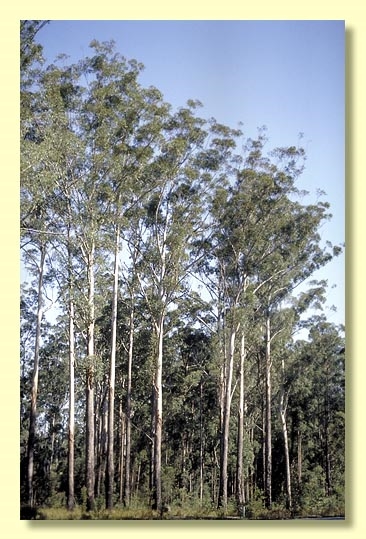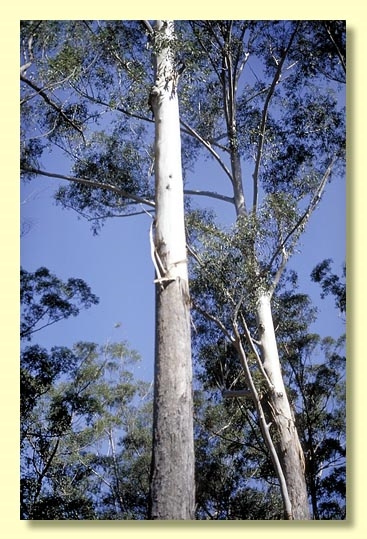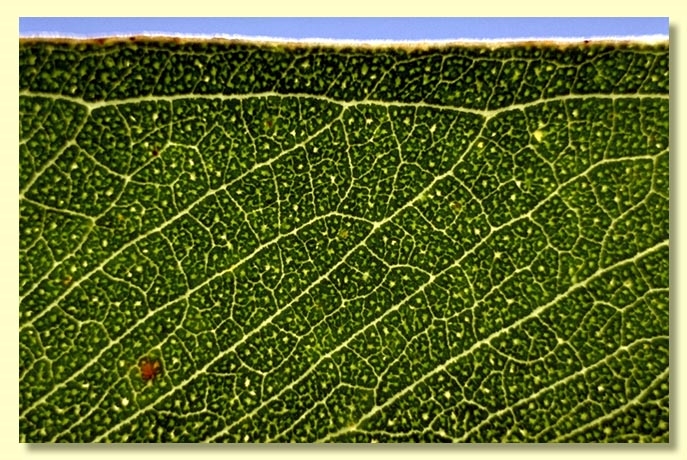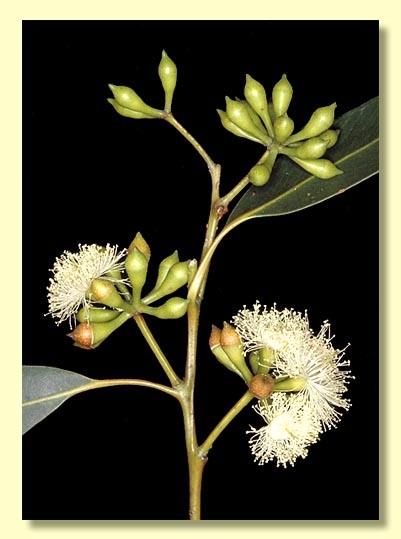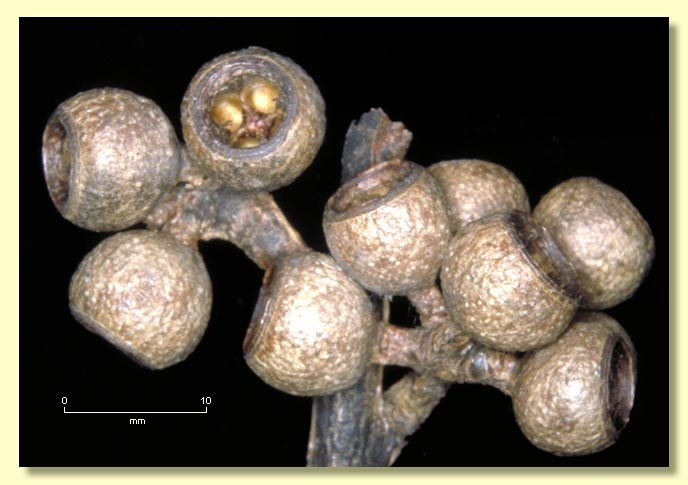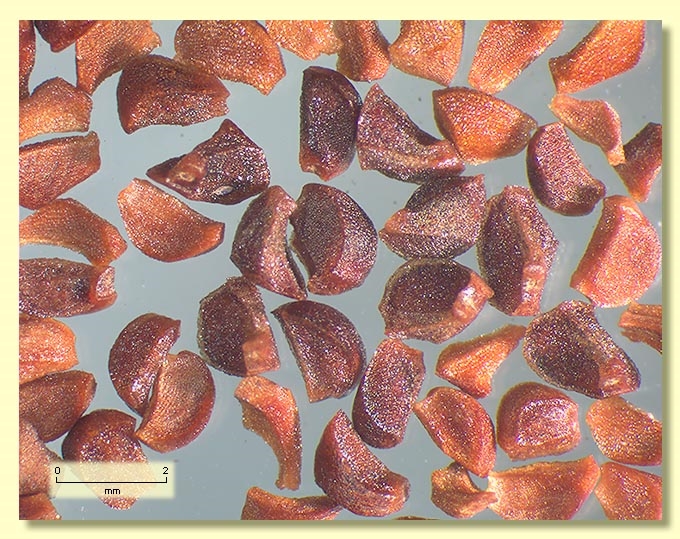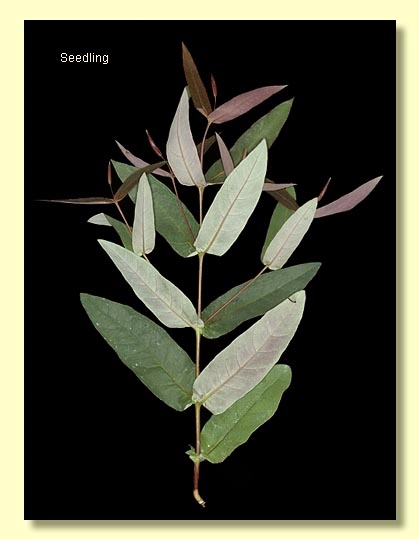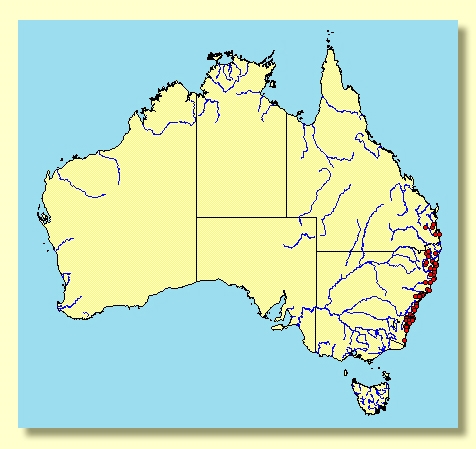Euclid - Online edition
Eucalyptus pilularis
Eucalyptus | Eucalyptus | Pseudophloius
T: Port Jackson, NSW, 1794, J.White s.n.; holo: LINN; iso: BM, NSW.
Eucalyptus persicifolia Lodd., Bot. Cab. 6, t. 501 (1821). T: cultivated in England.
Eucalyptus incrassata Sieber ex DC., Prodr. 3: 217 (1828) nom. illeg. non Labill. (1806). T: New Holland, F.W.Sieber 477; holo: G; iso: BM, F, K, MEL, NSW.
Eucalyptus semicorticata F.Muell., J. Proc. Linn. Soc., Bot. 3: 86 (1859). T: Brisbane River, Qld, July 1855, F.Mueller s.n.; holo: MEL ; iso: K.
Bark rough on lower half of trunk, finely fibrous, grey or grey-brown; smooth bark not powdery or granular, smooth bark cream to white or grey, often with scribbles.
Juvenile growth (coppice or field seedlings to 50 cm): stem square in cross-section; juvenile leaves opposite and sessile for many pairs (until early sapling stage), lanceolate, 5.5–13 cm long, 1–3.6 cm wide, bases rounded or almost amplexicaul, strongly discolorous, dull, green.
Adult leaves alternate, petiole 0.8–2.2 cm long; blade lanceolate to falcate, 7.5–17(19.5) cm long, 1.2–3.2 cm wide, base oblique to tapering to petiole, concolorous or slightly discolorous, glossy, green, side-veins greater than 45° to midrib, moderately to densely reticulate, intramarginal vein parallel to and well removed from margin, oil glands mostly island.
Inflorescence axillary unbranched, peduncles 0.8–2 cm long, buds 7 to 15 per umbel, on pedicels 0.2–0.7 cm long. Mature buds ovoid to diamond-shaped, 0.6–1 cm long, 0.3–0.5 cm wide, yellow or creamy, scar absent, operculum conical to beaked, stamens irregularly flexed, all fertile, anthers reniform to cordate, versatile, dorsifixed, dehiscing by confluent slits, style long, stigma blunt or tapered, locules usually 4, the placentae each with 2 vertical ovule rows. Flowers white.
Fruit on pedicels 0.1–0.7 cm long, hemispherical or truncate-globose, 0.5–1.1 cm long, 0.7–1.2 cm wide, disc level to descending, valves usually 4, enclosed or near rim level.
Seeds dark brown, 2–2.5 mm long, pyramidal or obliquely pyramidal, dorsal surface smooth, hilum terminal.
Cultivated seedlings (measured at ca node 10): cotyledons reniform; stems rounded in cross-section; leaves sessile and opposite for many nodes, lanceolate, 6.5–14 cm long, 1.2–3.7 cm wide, amplexicaul, margin entire, apex pointed, discolorous, dull, mid-green above, paler beneath.
Flowering has been recorded in January, February, March, April, July, October, November and December.
A medium-sized to tall forest tree of fertile south-east coastal plains and hills from south of Bega in far south-eastern New South Wales north to Fraser Island in south-eastern Queensland. It is closely related to only one other eucalypt, E. pyrocarpa. Known as blackbutts, these two species are characterised by rough fibrous bark over part or most of the trunk, prominent, opposite, sessile, glabrous, juvenile leaves, glossy adult leaves with dense reticulation, inflorescences with strongly flattened peduncles and relatively large buds and fruit in sevens to 15s, and red-brown seeds. Rough bark extends higher in E. pyrocarpa, the buds and fruit are usually glaucous, and the fruit are more obconical rather than truncate-globose. The opposite juvenile leaves distance it from ashes and stringybarks, and, while it may have parallels in peppermints, the leaf vein reticulation suggests that the blackbutts are closer to the white mahoganies.
Eucalyptus pilularis and E. pyrocarpa together form Eucalyptus subgenus Eucalyptus section Pseudophloius (the pseudo-stringybarks) because buds have a single operculum, anthers are reniform and ovules are in two rows, seeds are more or less pyramidal and juvenile leaves are opposite for many pairs on markedly square stems.

